July 11, 2008
Air Date: July 11, 2008
FULL SHOW
SEGMENTS
Climate and the Economic Summit
View the page for this story
At a recent meeting in Japan, the leaders of the developed world are moving towards an agreement to cut global greenhouse gases in half by 2050. However, they haven’t agreed on what level they’ll be cutting in half – current, or 1990 levels of emissions. Was it all a lot of hot air? Living on Earth turns to Elliot Diringer, Director of International Strategies for the Pew Center on Global Climate Change for an analysis of the meeting, and a look ahead. (05:00)
Life Under the Lid
/ Ingrid LobetView the page for this story
When the public had its first chance to comment on what life is going to be like under California's carbon limit, several people said put more emphasis on driving less. Living on Earth’s Ingrid Lobet reports. (05:15)
Word from the West
/ Ashley AhearnView the page for this story
Western governors and Canadian premiers say they hope to lead on energy policy in the new US administration, and their proposal will include participation from China. ()
EPA Woeful on Water and Warming
/ Jeff YoungView the page for this story
The Environmental Protection Agency says it needs more time to decide on its global warming policy – after suffering two embarrassing disclosures about its shortcomings on this issue and water pollution. Living on Earth's Washington correspondent Jeff Young sorts them out and explains how each instance also relates to important Supreme court decisions with major environmental implications. (05:00)
Recycling To Reduce Pesticide Use
/ Amy CoombsView the page for this story
After years of searching for an alternative for the kill-everything soil fumigant methyl bromide, one company thinks it may have an answer: leftover mustard seeds from biofuel production. Amy Coombs reports. ()
One Fish, Two Fish, Good Fish, Bad Fish
View the page for this story
Farm-raised Tilapia is growing in popularity in the United States but new research suggests that some of it may contain high levels of Omega six, which can lead to a myriad of health problems. Professor Floyd Chilton explains the research to host Bruce Gellerman and then Living on Earth gets a response from the American Tilapia Association president Bill Varano. (06:30)
Smart Sewers/Note on Emerging Science
/ Jessica IlyseView the page for this story
Mechanized sewers may be the answer to storm overflow getting into nearby water bodies. Jessica Ilyse reports. (02:00)
Beans Vs. Trees in the Amazon
View the page for this story
European consumer demand for ethically grown food has forced a moratorium in Brazil that will drastically reduce new deforestation for growing soy beans. Host Bruce Gellerman talks with Lindsey Allen, a forest campaigner for Greenpeace. (07:00)
Genetically Modified Joe
/ Julie GrantView the page for this story
One day soon, coffee beans might be grown free of caffeine. One biotech company hopes to genetically modify the plant so that the beans won’t need to be stripped of caffeine, because they won’t be making it to begin with. "The DNA Files" producer Julie Grant reports. (04:15)
A Recyclable Olympic Stadium
/ Kim GittlesonView the page for this story
One company proposes removable, reusable stadium seats to minimize leftover space after the Olympics leave town. Kim Gittleson reports. (02:40)
This week's EarthEar selection
listen /
download
A night-time chorus of chirruping insects from the Brazilian rainforest.
Show Credits and Funders
Show Transcript
Host: Bruce Gellerman
Guests: Elliot Diringer, Bill Verano, Floyd Chilton, Lindsay Allen
Reporters: Jeff Young, Ashley Ahearn, Ingrid Lobet, Kim Gittleson, Jessica Ilyse Smith, Amy Coombs, Julie Grant
[THEME]
GELLERMAN: From Public Radio International - its Living on Earth. I’m Bruce Gellerman.
World leaders put the pedal to the metal, pledging for the first time to cut greenhouse gas emissions in half by 2050, but skeptics doubt they can get from here to there.
DIRINGER: They didn’t put themselves on record with a strong declaration that they’re prepared to meet early targets - the kind of targets you’d need to meet if you’re ever going to meet that long-term goal.
GELLERMAN: Also, new research suggests one of America’s favorite fish may not be a healthy dish.
CHILTON: Tilapia would contain far higher concentrations of the long chain omega sixes than one would see in a large hamburger or two or three doughnuts.
GELLERMAN: Farm raised Tilapia comes under fire. And recycling stadiums so poor nations can compete to host the Olympics. These stories, this week on Living on Earth. Stick around!
[NPR NEWSCAST: Boards Of Canada “Zoetrope” from “In A Beautiful Place Out In The Country” (Warp Records 2000)]
Climate and the Economic Summit
GELLERMAN: From the Jennifer and Ted Stanley Studios in Somerville, Massachusetts - this is Living on Earth. I’m Bruce Gellerman, in for Steve Curwood. By 2050 the world could see greenhouse gas emissions slashed in half. That’s the promise made by world leaders, meeting in Japan at the G-8 summit of industrial countries. President Bush declared the meeting a success, but some aren’t so sure, saying the fine rhetoric lacks fine print. Elliot Diringer is the director of International Strategies for the PEW Center on Global Climate Change. Hello Mr. Diringer.
DIRINGER: Glad to be here.
GELLERMAN: So what really did happen in Japan? Is this a lot of talk and not much substance?
DIRINGER: Well, I think, you know, if you look at the history of the G8 really the most it ever can accomplish is amassing a crystallization of some political will. That’s not the place where countries sign on to binding agreements. It’s the place where some leaders try to apply pressure to other leaders to move them along and reach a higher level of political consensus. And I think we saw that to some degree here, the willingness to embrace that goal of 50 percent reduction by 2050, that’s a step forward. But they didn’t put themselves on record with a strong declaration that they’re prepared to meet early targets, the kind of targets you’d need to meet if you’re ever going to meet that long-term goal. So that really was a shortcoming and it was a missed opportunity to show some leadership.
GELLERMAN: The G8 countries have pledged to cut greenhouse gases by half by 2050. But the question is: half of what?
DIRINGER: Well, they actually didn’t specify that, it was left open. Does that mean 50 percent below 1990 levels which some believe is what’s needed or is it 50 percent below current levels. By not specifying I think really the only way to interpret it is 50 percent below current levels.
GELLERMAN: But would that be enough to forestall or prevent runaway global warming?
DIRINGER: It may prevent runaway global warming. It’s probably not going to prevent all serious climate change but it will do a great deal to reduce the odds of catastrophic impacts. I think it’s important to put this in some perspective and see what we’re really up against here. I mean right now emissions are growing faster than ever. They’re projected to grow 130 percent by 2050 so what we’re talking about is avoiding all of that growth and then reducing another 50 percent below where they are today. That’s really an epic undertaking.
GELLERMAN: So what will it take to accomplish that then?
DIRINGER: Really it requires a revolution in the way we produce and use energy. Tremendous improvements in energy efficiency, transitioning to other types of energy, non-fossil energy, and where we continue to rely on fossil energy finding a way to capture those greenhouse gas emissions and bury them in the ground. It’s gonna require really serious efforts on a number of fronts.
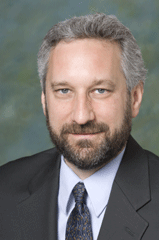
Eliot Diringer
DIRINGER: Well there will be opportunities along the way for the G8 and for others to offer up stronger statements and work towards a deal. The deal hopefully will be cut in Copenhagen that’s the goal that’s been set by all of the parties to the UN Framework Convention on Climate Change. I think that’s going to be pretty tough actually. I think we might hope to see the broad outlines of a deal come out of Copenhagen but I think most of the details will probably have to be negotiated even beyond then.
GELLERMAN: Well President Bush is calling the meeting a success. Would you agree?
DIRINGER: Well I think if you had reasonably low expectations going in and I think those are the only realistic expectations to have, then they were met. So if that’s the measure of success then yeah I think it was a success. But I think in measured against the scale of effort that’s needed, the urgency of the issue, I don’t think you could really stack it up as a great success.
GELLERMAN: When a new President takes office, a new administration takes office, in January, do you expect things to change?
DIRINGER: Absolutely. I think there are very strong indications from both of the candidates that they’ll be prepared to approach this issue much more aggressively both on the domestic front and internationally. Just how quickly and just how far they’ll be prepared to move, I think we’ll have to see, we’ll have to see what other issues are on their plate the day they walk into the Oval Office. But I think absolutely we can certainly expect a different posture from the US within the international negotiations.
GELLERMAN: Elliot Diringer is the Director of International Strategies for the PEW Center on Global Climate Changes. Mr. Diringer, thank you very much.
DIRINGER: You’re very welcome.
Related links:
- The Pew Center on Global Climate Change
- To learn more about the Pew Center's ongoing work toward a post-2012 international climate agreement, click here
[MUSIC: Todd Sickafoose “Future Flora” from ‘Tiny Resistors’ (Cryptogramophone Records—2008)]
Life Under the Lid
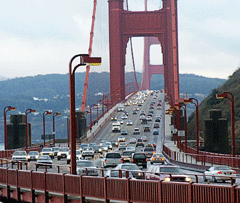
Commuting over the Golden Gate bridge in northern California. (Photo: Steven Shupe)
GELLERMAN: California hopes to become the first state in the nation to effectively reduce climate change gases. By state law, California must cut climate change emissions to what they were in 1999. The state’s come up with a plan and in Los Angeles officials have just held their first public meeting to discuss the details. But as Living on Earth's Ingrid Lobet reports, some who attended say the plan doesn't go far enough.
LOBET: If you take all the emissions from cars, trucks, power plants, buildings, cows, everything in California, and divide it by the number of residents, you get 14 tons of gases per person per year. That must be chopped down to 10 tons.
TIM O'CONNOR: This is equal to taking 28 million cars off the road by 2020. Even putting it another way, it's like shedding all the emissions inventory of Missouri, the fifteenth largest emitter of all the US States.
LOBET: That's Tim O'Connor of the Environmental Defense Fund, just one of dozens to testify at this first hearing on California's broad plan to cut CO2 emissions from everything. Fran Pavley spoke up early in the hearing. She's the former fifth grade teacher and former assemblywoman who in her first term, shepherded California's earliest climate change law through the state legislature.
PAVLEY: We are all part of history. When this was passed, I hadn't realized how quickly we are facing tangible evidence of climate change directly to California. And probably the most direct impact has been our wildfires - yearlong wildfire seasons.
LOBET: And Pavley, who now travels and speaks as a climate change guru, urged officials to face up to one of the country's thorniest problems: the long distances people drive from homes to work.
PAVLEY: How do we incentivize cities and builders to change from continuing California's pattern of sprawl and dependence on the automobile, instead of creating those walkable neighborhoods and towns linked by effective public transit?
LOBET: Addressing the reality of how many miles we drive, of land use, is more complicated than cutting emissions from a factory. And more people took the podium for this issue than any other. Michael Woo spoke for a new coalition that's come together on this issue to try to end the era of distant suburbs built without taking into account the ensuing car exhaust. Woo took officials to task for giving the problem short shrift.
WOO: The emissions reduction target for land use sector is set by the draft plan is abysmally low. Because transportation is largest single source of greenhouse gas emissions, and because our sprawling land use patterns are the prime cause, of our overuse of automobiles and our over dependency on gasoline, the draft plans light touch on land use means the plan misses the historic opportunity to directly address one of California’s main contributions to climate change.
LOBET: Woo and several others pleaded with officials to put a ceiling on emissions from each town or region. That would force local authorities to reduce sprawl and increase buses and trains. Pam O'Connor is an LA County transit board member and a city councilwoman from Santa Monica. She and others said public transit needs to be properly funded, as it's increasingly part of the climate change solution
PAM O'CONNOR: Funding is being reduced, at a time when it is most needed and at a time when the transit sector is experiencing record ridership.
LOBET: As climate action advances and activities shift toward lower-carbon options, like buses and trains, some of those options will see their emissions increase. O'Connor insisted communities with mass transit must be credited for their success.

Commuting over the Golden Gate bridge in northern California. (Photo: Steven Shupe)
LOBET: Particularly if those fleets run on natural gas.
PAM O'CONNOR: Our transit buses are as clean as we can get them. We're the nation's largest clean fleet. The buses are 97% cleaner than diesel. We have 1.8 megawatts of solar power, the largest renewable energy provided in the United States transit industry.
LOBET: Some businesses are also speaking up for mass transit. Carolyn Casavan is CEO of an environmental consulting firm.
CASAVAN: As an employer, I'm concerned about my employees being able to get to work as the gasoline price continues to rise.
LOBET: California's path toward cutting 80% of emissions by 2050 will take clearer form over the summer. The state predicts these changes will save two billion dollars in health costs avoided. But there will be significant costs for some players in the short term, and as those costs come into focus, the discussion will doubtless become more heated.
For Living on Earth, I’m Ingrid Lobet.
Related link:
Tune in to the next hearing on the web
Word from the West
GELLERMAN: California isn't the only state with big ambitions on climate change. Here’s Living on Earth’s Ashley Ahearn.
AHEARN: Governors from 19 Western states met in Wyoming recently and vowed to come up with a plan for just how much of the nation’s energy should come from renewable sources. Natural gas, nuclear, wind, solar and clean coal are big in their home states.
But Montana’s Governor Brian Schweitzer say the western states’ efforts are being undercut by those who doubt climate change is real.
SCHWEITZER: We still have groups traveling across this country right now that are financed by some energy companies, financed by utilities companies, who say well, its junk science, and so now we have legislators in each of our states who mimic that.
AHEARN: Leading the Western Governor’s effort is the group’s new chairman, Jon Huntsman of Utah. Governor Huntsman is a former US ambassador to Singapore. He speaks fluent Mandarin and brought Chinese officials to this year's meeting in Jackson, Wyoming. He says there’ll be no break in the international deadlock on climate without Asian involvement.
HUNTSMAN: It is not being done at any level. And wherever I go I am always sort of reminded by observers that it doesn't matter how far we go because you’ve always got China and India to worry about, well I'm tired of hearing that. I think its about time we engage China in some sort of meaningful dialogue, and this may be where it begins, and if it does, so be it.
AHEARN: The Western Governors say they’ll present their new energy plan to the next U.S. president. For Living on Earth, I’m Ashley Ahearn.
[MUSIC: Marc Ribot “Fuego” from ‘Ceramic Dog’ (Pi Records—2008)]
GELLERMAN: Coming up: mmmm – Strawberries …and MUSTARD? The recipe just ahead on Living on Earth.
Related link:
For more on the Western Governors' Association meeting, click here
[MUSIC: Jeff Coffin: “Turiya” from MuTopia (Compass Records 2008)]
EPA Woeful on Water and Warming
GELLERMAN: It’s Living on Earth, I’m Bruce Gellerman. The U.S. Environmental Protection Agency now says it needs more time before it can decide whether to regulate greenhouse gases, this despite a Supreme Court ruling requiring that EPA decision. EPA’s new schedule effectively means there will be no new climate change regulations until there’s a new president. The EPA’s announcement capped an ugly week for the agency. Back to back embarrassing revelations shed light on the EPA’s handling - or mishandling - of both global warming and water pollution. Living on Earth’s Washington correspondent Jeff Young is here to explain.
YOUNG: Hi Bruce.
GELLERMAN: Hi Jeff. So let’s begin with global warming. I guess a high level official at the EPA quit and now he’s kind of spilling the beans?
YOUNG: Mmhmm. Jason Burnett is his name. He was Associate Deputy Administrator in EPA that’s pretty high on the food chain there. Now he’s written a letter responding to some questions from the Senate’s Environment Committee and he gives a blow-by-blow account of the White House refusing to accept EPA’s finding that greenhouse gases might endanger public welfare. And he also spells out how Vice President Cheney’s office forced changes in some Congressional testimony that linked global warming to public health threats.
GELLERMAN: I remember that incident. The director of the Center for Disease Control was supposed to tell Congress about global warming and public health and then someone told her to change her testimony.
YOUNG: That’s right. The statement originally had examples of climate change increasing the likelihood of insect-born disease, worse air pollution, wildfires. Now there’s ample scientific support for those statements but for some reason they got cut. That infuriated Senator Barbara Boxer, she’s the California Democrat who chairs the Senate’s Environment Committee.
BOXER: This administration wants to downplay the threat global warming poses. And therefore it’s almost like they galvanize themselves into action when anyone in their own shop says, “Wait a minute, this is a problem.”
YOUNG: And Burnett’s letter says it was the Vice President’s office making those changes.
GELLERMAN: So why would Vice-President Cheney or someone on his staff be so concerned about that?
YOUNG: Well remember this all happened while EPA was weighing how it was going to respond to the Supreme Court’s big global warming decision from last year. And recall the court told EPA, “You’ve got to make a decision on regulating greenhouse gases.” Well, the first step in that process is to decide whether greenhouse gases might harm public health. And Burnett’s letter gives a fascinating sort of play by play on how the White House just refused to accept the EPA’s finding on this back in December. When Burnett emailed the finding to the White House, someone at the White House told him to say it was a mistake, that he had sent it in error. And he refused to do that.
GELLERMAN: And then what?
YOUNG: Well apparently the White House just didn’t open his email.
GELLERMAN: So they didn’t get it. So Jeff how much of this is just politics?
YOUNG: Well, you know clearly the Democrats in Congress hope to score some more hits on the Bush Administration with this and anything that implicates Cheney’s office is going to help them on that. It also turns out the person releasing this information, Jason Burnett, is a major campaign donor to Democrats.
GELLERMAN: Okay now as if that weren’t bad enough for the Environmental Protection Agency, the Agency’s also under pressure for its enforcement of the Clean Water Act, or rather its lack of enforcement. Jeff, what’s that story about?
YOUNG: Oh now this comes from an internal memo by the EPA’s top enforcement official and it says that the EPA chose not to enforce the Clean Water Act in about 300 cases that dealt with small streams and wetlands. A California Democrat Henry Waxman chairs the House Oversight Committee. He caught wind of this memo and made it public.
WAXMAN: The impact of choosing not to enforce the Clean Water Act and the protections that it’s supposed to give to our waterways is totally out of line with Congressional intent. In fact, I think it’s a de facto repeal of this important law.
GELLERMAN: Ooh, strong words, repeal the Clean Water Act. What’s the EPA’s explanation Jeff?
YOUNG: Well, curiously, this is another instance where EPA’s having trouble dealing with a Supreme Court decision. In this case, a 2006 ruling in a Clean Water Act case that was supposedly going to clear up this lingering question about whether the act would apply to these small seasonal streams and wetlands that do not have an obvious connection to larger waterways. But the decision was kind of a mess, the Court split, and pretty much just said, “Okay regulators, you’re going to have to take a case by case approach.” So now each time somebody say, dumps waste into one of these intermittent streams or a developer bulldozes a small wetland, EPA faces a major legal decision every time. And this memo shows us that in hundreds of cases EPA has just decided its too much trouble to enforce the law.
GELLERMAN: So what happens now?
YOUNG: Well Congressman Waxman wants an explanation from EPA and there’s also a bill pending in Congress that could clear this up. It’s called the Clean Water Restoration Act but it has a lot of opposition and it’s been bottled up in committee for months.
GELLERMAN: Living on Earth’s Washington correspondent, Jeff Young. Jeff, thanks a lot.
YOUNG: You’re welcome Bruce.
Related links:
- Former EPA official Jason Burnett’s letter on White House and EPA global warming decision-making.
- Rep. Henry Waxman’s letter to EPA regarding Clean Water Act enforcement, and the EPA memo that triggered it:
- Related LOE coverage on EPA’s response to the Supreme Court’s global warming decision…
- …and the high court’s mixed ruling on Clean Water:
Recycling To Reduce Pesticide Use
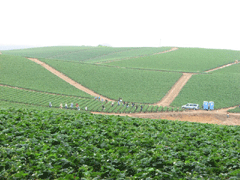
Methyl bromide might not be in strawberry fields forever if organic alternatives to the pesticide are successful. (Photo: Sara Stasi)
GELLERMAN: Let us take you down along California’s Central Coast, where almost half of the nations strawberries are grown, there’s much to get hung about. A lot of the soil there is still treated with one of the world’s most controversial pesticides. But these treated strawberry fields may not be forever. The EPA has just set more stringent standards to protect workers and researchers are working on a non-toxic alternative. Reporter Amy Coombs has our story.
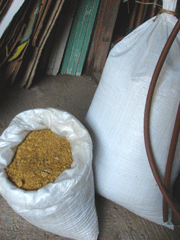
Pesticide of the future? (Photo: Stephanie Bourcier)
[Keyboard]
ROACH: Methyl bromide is a general biocide, so it kills pretty much everything. That’s why it’s so effective. It’s effective against a lot of insect pests, mites, diseases like fungal diseases of the soil, nematodes, weeds.
COOMBS: It’s also extremely harmful if workers accidentally come into contact with it, and it’s one of the last major contributors to the hole in the ozone layer. This is why many countries have entirely quit using methyl bromide, and the U.S. committed to phase it out by 2005. But that hasn’t exactly happened. In most strawberry fields, methyl bromide gas is still pumped through the soil before planting.
ROACH: Probably 97 percent are grown using some sort of fumigation - either methyl bromide or one of the alternatives.
COOMBS: The federal government still offers better insurance premiums when methyl bromide is used, because the crops are considered less likely to fail. And since strawberries are one of the most expensive crops to plant, farmers say they can’t afford to experiment with alternatives. Despite years of research, many chemical replacements don’t seem to work as well anyway, and organic methods can take years to implement.
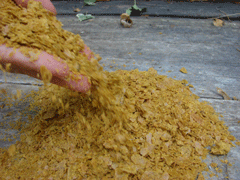
After mustard seed is pressed to make biodiesel or cooking oil, it leaves behind a brown meal that can be used as an alternative pesticide. (Photo: Stephanie Bourcier)
COOMBS: But now one company, called Farm Fuel Incorporated, may have a non-toxic option available - ground up mustard seed.
[OCEAN, BIRD AMBIENCE]
COOMBS: On a farm that overlooks the sea, the company’s biologist, Stephanie Bourcier, pours cups of seed meal onto rows of black earth.
BOURCIER: What we do now is apply the meal by hand into an already prepared bed.
[SEED MEAL SOUND]
COOMBS: As sea lions bark on the beach below the farm.
[SEA LIONS, OCEAN]
COOMBS: Bourcier smiles as she inspects rows of mature plants grown using seed meal.
[LEAVES RUSTLING]
BOURCIER: You can tell this is a healthy plant by these large healthy mature leaves, also there are young leafs sprouting. This plant also has many flowers and berries growing.
COOMBS: In one test Bourcier planted a field treated with seed meal next to one treated with methyl bromide. So far, the seed the meal seems to be working just as well as conventional methods - at least when it’s applied in the right concentrations.
BOURCIER: We are trying to figure out how much meal needs to be applied for strawberries - how much is too much? How much is too little? What we want to find is the right balance, so we will apply the meal by different weights.
COOMBS: Farm Fuel still has to test the seed meal on large plots - with tractors and industrial techniques - before its marketable. But Sonoma State University biologist Mike Cohen predicts this will go smoothly. Cohen has studied the properties of ground seed, and says they contain glucosinulates - the same types of compounds found in horseradish that make your mouth burn.

Strawberry fields in Watsonville, California. (Photo: Sara Stasi)
COOMBS: Cohen also discovered seed meal has another benefit. It cultivates good bacteria in the soil, which helps the plants produce root hormones, strengthening their resistance.
COHEN: The seed meal also works by stimulating the growth of bacteria that help plants defend themselves against pathogens.
COOMBS: This is a very different approach to pest management, says Cohen. Over time, the seed meal helps the soil become healthier, while Methyl bromide may pave the way for more pathogenic invasions.
COHEN: So the strategy with methyl bromide is simply to wipe out everything in the soil - the entire community. Basically what you have established then in the soil is a vacuum, in which if a pathogen lands it can quickly invade since it doesn’t find any competitors, and reproduce and spread in the soil, thereby necessitating another application of the fumigant not very far down the line.
COOMBS: It’s a difficult cycle to break. This is why Agricultural Commissioner Bob Roach says despite seed meal alternatives, farmers aren’t going to abandon something they know works. Even if the seed meal proves itself in the field, it will likely have to be combined with other organic farming methods, and the industry might not be open to this much change.
ROACH: The production system using fumigation to produce strawberries has been around for a lot of years, and it’s a very successful pest management system. You fumigate, you basically clean up all pests, all weeds, and you don’t have any more problems with those when you use methyl bromide.
COOMBS: Yet eventually farmers will have to make a break with methyl bromide. Even though the industry has delayed, the chemical will be phased out. Bourcier hopes that even if seed meal doesn’t kill everything in the soil, it’s quick acting purification will help more farmers switch to organic methods. If tests go well, Farm Fuel will begin testing seed meal on large-scale farms next year. In the mean time, Bourcier hopes people will make an effort to buy organic strawberries.
For Living on Earth, I’m Amy Coombs
Related link:
Check out Living on Earth's previous coverage of methyl bromide
[MUSIC: Marc Ribot “Malena” from ‘Ceramic Dog’ (Pi Records—2008)]
One Fish, Two Fish, Good Fish, Bad Fish

Even when it’s not pan-seared with bacon, farm-raised tilapia might not help lower your cholesterol. (Photo: Greg Turner)
GELLERMAN: Doctors and moms agree - fish is good for you - especially oily fish: salmon, mackerel, and sardines. Besides being brain food, the omega 3 fatty acids in these fish are thought to prevent heart disease and fight cancer. But now, a new federally funded study suggests eating one of America’s favorite fish, tilapia, could actually be harmful. Professor Floyd Chilton and his colleagues at Wake Forest University Medical Center found farm-raised tilapia contains low levels of beneficial Omega 3’s and dangerously high levels of bad Omega 6 fatty acids. Their research appears in the current edition of the Journal of the American Dietetic Association. Professor Chilton welcome to the show.
CHILTON: Thank you, Bruce, it’s great to be with you today.
GELLERMAN: So as I understand it professor, you tested farm-raised tilapia from around the world.

Processing farm-raised tilapia in Petatan, Mexico. (Photo: Steven Miller)
GELLERMAN: These fish have been around since biblical times. Why only now are you measuring the fatty acids in tilapia?
CHILTON: Well there has been an explosion in the consumption of tilapia. Five years ago this fish ranked tenth among seafoods consumed in the United States. Within the last five years it’s moved to five. Among finfish, it is the number two and it is fast approaching Atlantic salmon. So we are now just catching up with the biochemistry, if you will, of these fish as we’ve seen the consumption increase so very, very rapidly.
GELLERMAN: What’s the concern with Omega 6 fatty acid?
CHILTON: Omega 6 fatty acids and especially what we scientists call long-chain Omega 6 fatty acids, in particular a fatty acid called arachidonic acid forms the basis of these pro-inflammatory messengers that control many of the diseases that we see associated with inflammation.
GELLERMAN: So like arthritis, heart disease, autoimmune diseases.
CHILTON: Exactly - allergy, asthma, diabetes - now we’re understanding the roles of these fatty acids in depression and cancer and Alzheimer’s disease. So inflammation is a very, very large umbrella.
GELLERMAN: So compare tilapia to other foods I might eat.
CHILTON: Tilapia would contain far higher concentration of those long-chain Omega 6’s such as arachidonic acid than one would see in a large hamburger or two or three donuts. From an inflammatory messenger perspective, certainly tilapia is not sending the right message.
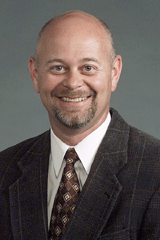
Dr. Floyd Chilton is a professor at Wake Forest University.
CHILTON: Absolutely. And that’s the reason I believe that this study is so important. Let me be clear: I don’t believe that there’s anything that we can do better for human health than eat the right type of fish, to eat oily fish, to take dietary fish oils. The effectiveness of this approach is just absolutely unequivocal at this point. However, as this study points out, all fish are not the same, and we have to be much more specific in our recommendations especially with a fish that is emerging so rapidly and gaining popularity so quickly.
GELLERMAN: So what is it about farm-raised tilapia?
CHILTON: In a fish-farming situation, the fish that you get depends on what they are fed. Now if these fish are fed, as in the wild, Omega 3 fatty acids and algae, then they’re going to have long-chain Omega 3 fatty acids, which are going to be incredibly beneficial. However, if these fish are fed short-chain Omega 6 products that comes from corn products which is happening so often now then what one sees is the long-chain detrimental Omega 6 fatty acids. So really the fish really are what they eat and we really are what we eat as well.
GELLERMAN: So if you eat wild tilapia as opposed to farmed tilapia you can assume that that’s pretty good for you?
CHILTON: It is. It’s just almost impossible to find wild tilapia. Bruce, I think the other important point here and certainly the important point that I say to people is: we’ve done this before, we went from whole grains to refined grains that really led to an unmitigated health disaster. When we went to, when we changed our animal husbandry practices from grass to corn-fed, really a disaster. A central axiom for us is first “do no harm” and I think we really need to take that approach to our food supply.

(Photo: Greg Turner)
CHILTON: Thank you Bruce, great to talk to you.
GELLERMAN: We called the American Tilapia Association for a response to Professor Chilton’s study, the Association’s President Bill Verano calls the study sound science. And says not all tilapia is created equal.
VERANO: Our position is: “Fish is not fish. Fish is only what it is fed and where it is grown.” We’re strongly in favor of encouraging people to buy domestic where food is carefully selected. We cannot condone what the rest of the world has produced. 98 percent of the Tilapia that’s purchased in the markets in the United States is imported. The feeding program is different, the growing conditions are different. Insist on US, American-grown tilapia and you will have a nutritional, balanced product. And we at the Tilapia Association invite anyone to be willing to test our product at any time.
GELLERMAN: Bill Verano is President of The American Tilapia Association.
Coming up: A new deal to protect the Amazon Rainforest. Stay tuned to Living on Earth!
ANNOUNCER: Support for the environmental health desk at Living on Earth comes from the Cedar Tree Foundation. Support also comes from the Richard and Rhoda Goldman Fund for coverage of population and the environment. And from Gilman Ordway for coverage of conservation and environmental change. This is Living on Earth on PRI—Public Radio International.
Related links:
- American Tilapia Association
- Click here to read the study
[MUSIC: Todd Sickafoose: “Paper Trombones” from Tiny Resisitors (Cryptogramophone Records 2008)]
Smart Sewers/Note on Emerging Science
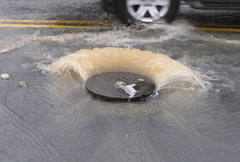
The effects of combined sewer overflow in West Haven, Connecticut. (Photo: Christopher Zurcher/CTEnvironmentalHeadlines.com)
GELLERMAN: It’s Living on Earth. I’m Bruce Gellerman. Just ahead – how about a nice hot cup of genetically modified joe? But first this note on emerging science from Jessica Ilyse Smith.
SMITH: What happens when crisis strikes the sewers?
[MUSIC: Teenage Mutant Ninja Turtles Theme Song]
SMITH: No, it’s not the Teenage Mutant Ninja Turtles to the rescue, but engineers working to save our waterways from sewage overflows.
[SCIENCE NOTE THEME]
SMITH: Researchers at both Purdue and Notre Dame University have teamed up with the company, EmNet, to create a network of mechanized sewers for the city of South Bend, Indiana. Their goal is to reduce overflow of raw sewage into nearby waterways during heavy rain. Overflow is a problem for nearly 770 cities in the U.S., where everything from toilet waste to street-water runoff is combined in one sewer system. This method leaves little capacity for water build-up during a large storm.
Combined sewer overflows are problematic for both aquatic ecosystems and humans, who use lakes and rivers for recreation. Raw sewage released into waterways may contain E. coli, as well as other disease-causing bacteria and parasites. The EPA estimates there are at least 40,000 such overflows each year.

The effects of combined sewer overflow in West Haven, Connecticut. (Photo: Christopher Zurcher/CTEnvironmentalHeadlines.com)
Now, that’s Turtle Power!
That's this week's note on emerging science; I'm Jessica Ilyse Smith.
Beans Vs. Trees in the Amazon
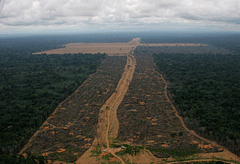
In Gleba do Pacoval, 1,645 hectares was illegally logged to clear land for soy plantations. (Courtesy of Greenpeace)
GELLERMAN: The price for soybeans is soaring as more and more soy is being used to replace petroleum. These days you’ll find the flexible bean in everything from plastics to gasoline. With increased demand comes increased pressure on farmers to plant soy wherever they can - and even places they’re not supposed to, like Brazil’s Amazon Rainforest. That’s why a new agreement to ban soybeans grown in the rainforest could play a big role in preserving the region. The moratorium removes the farmers’ economic incentive. Lindsay Allen of Greenpeace helped broker the deal. Hi Lindsay!
ALLEN: Hi Bruce.
GELLERMAN: So how does this moratorium work?
ALLEN: Well the moratorium works by ensuring that there isn’t new deforestation in the Amazon for soy and it sets in place the monitoring mechanisms so that the big traders like Cargill, ADM, and Bunge can know that the soy they’re getting and sending to market isn’t coming from farmers who have deforested.

An aerial view of the Amazon rainforest (Courtesy of Greenpeace)
ALLEN: It’s their economic interests because before we announced the moratorium we released a report called “Eating up the Amazon.” And it was essentially a case study that walked from soy in the hands of the farmers to the hands of Cargill, Cargill would then send it to Europe to be animal feed, and those animals were then going into McDonalds’ chain of custody. So the pressure that we were able to exert on McDonalds they in turn exert on Cargill. And knowing that deforestation of the Amazon not only is devastating to biodiversity but it also has an impact on climate change, given Brazil is the fourth-largest greenhouse gas emitter, McDonald’s has European customers who refuse to buy Amazon soy.
GELLERMAN: Well why now? I mean these farmers have been cutting down the forest to grow food for years. What’s the impetus for the action now?
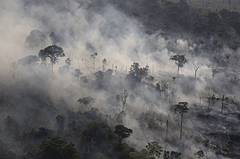
Farmers burn unwanted trees to add nutrients to the soil and prepare it for agricultural domestication. (Courtesy of Greenpeace)
GELLERMAN: But with the world price of commodities, particularly soy, going up so high, wouldn’t it make sense to have farmers cultivate more soy and bring the price down? I mean there’s people that are going to go hungry because they won’t have soy products.
ALLEN: Not necessarily. So Brazilian soy is cheaper to grow in the Amazon because people are grabbing land, they’re growing soy in protected areas, they’re growing soy in ecological reserves, and they’re not paying for this land. They’re also not paying for the workers often times so we see a large intersect between slave labor and soy being grown because of these illegal operations that are moving into the Amazon. When soy was first introduced in Brazil it wasn’t thought that it would be able to grow in the Amazon because of the climatic and the soil conditions, it was assumed that it would have to stay in the south and so it is a pretty recent surge that we’ve seen in moving soy into the Amazon itself.

In Gleba do Pacoval, 1,645 hectares were illegally logged to clear land for soy plantations. (Courtesy of Greenpeace)
ALLEN: Well we don’t look at the soybean we look at the farm. So the mapping and the monitoring and the land registration all go together and what we do is we want to have maps to a scale where we can, as soon as we see deforestation happen, we note it. We know who owns that land, we know what has been planted there, we know if it’s related to cattle grazer, rice production, soy production, and we then essentially blacklist those farmers so that the traders know that they cannot buy from these farmers even if part of the farmer’s land has been used legally to grow soy if they’ve deforested a new area they will be blacklisted and the traders have agreed to this as part of the moratorium.
GELLERMAN: Lindsay I understand that Brazil is going to extend the soy moratorium to include timber and cattle. Is that true?
ALLEN: We hope so. The way that soy works is it’s not planted right away. First they’ll go in, they’ll have someone come in and log them or they’ll log themselves for the timber that is most profitable. The next step would be because there’s still stumps and there’s still brush that needs to be removed they get someone to clear the land a bit more, being able to plant grasses, and then they can bring in cattle to ranch on that area. And eventually they can use the cattle that they get to market to pay folks to come in, take out the stumps, and plant rice, and really domesticate the soil so that it can grow soy because soy right now is the most profitable crop to get to market. Our goal in working with the Brazilian government is to really get them to sign on to a zero deforestation platform because the Amazon not only is it important to biodiversity but also for preventing catastrophic climate change.

Lindsey Allen is a forest campaigner with Greenpeace. (Courtesy of Lindsey Allen)
ALLEN: They did, that was in the state of Pará and it was part of, it was sending out IBAMA, which is essentially the Brazilian EPA with guns and they confiscated the cattle and they’ll be, as long as a judge approves it, they’ll be auctioned with the proceeds going to a hunger program and healthcare for indigenous tribes there.
GELLERMAN: Lindsay you are stepping on some of the biggest toes in the world. Isn’t Greenpeace afraid of being there?
ALLEN: It is dangerous to be in the Amazon but we have a tremendous responsibility to protect such an important ecosystem not just to secure such a biodiverse place but also to limit the impacts of climate change. So Greenpeace has been in the Amazon for quite awhile. We have an office right in the middle of things, and it’s heavily guarded, and we do take security precautions but it’s important for us to be there.
GELLERMAN: Lindsay Allen is a forest campaigner with Greenpeace. Lindsay, thanks a lot.
ALLEN: Thank you.
Related link:
Greenpeace Homepage
Genetically Modified Joe

(Photo: Nat Hansen)
GELLERMAN: Soybeans aren’t the only thing grown in Brazil.
[MUSIC: Frank Sinatra “Coffee Song” from a You Tube video]
GELLERMAN: And it’s fair to say not one of those billions of beans is decaf - at least not ‘til it’s processed. But a small biotech company hopes to change that. It’s developing a coffee bean that has no caffeine. In a story originally produced for the radio project The DNA files, Julie Grant wakes up and smells the coffee.

(Photo: Nat Hansen)
RIVERA: We're going to talk about what goes on with roasting…
GRANT: Joseph Rivera is director of science and technology for the Coffee Association. He's teaching a class in decaffeination. Here's how it works. The green beans are steamed to soften and swell them. Then they're mixed in big stainless steel chambers with solvents.
RIVERA: It's just kind of a big laundry mat, if you will. Things are being
mixed up and swirled around.
GRANT: During all of that swirling, the caffeine molecules separate from the beans and attach to the solvents. They're siphoned out of the chamber, and what's left inside are the decaffeinated beans.
RIVERA: You have to realize that these beans have gone through a lot. They've been stressed out. They've been steamed. They've been beat up in these containers. They've been subjected to chemicals.
GRANT: Rivera says the chemical used in 60% of coffee decaffeinated in the U.S. is methylene chloride, the same stuff used in paint strippers and degreasers.
RIVERA: People don't like to hear that. [laughs] They don't like to hear that it's in paint remover. It's used in a number of different things.
GRANT: And Rivera says there's no denying that once you change the chemical make-up of the beans like this, you change the flavor of the coffee. That's where one scientist walking around the coffee conference sees his opening.
STILES: I'm John Stiles. I'm chief scientific officer for Integrated Coffee
Technologies.
GRANT: What is Integrated Coffee Technologies?
STILES: We're a small - I guess you'd say a boutique biotechnology company - that focuses on coffee and a few other tropical crops.
GRANT: Stiles says he prefers regular coffee to the decaf on the market today, including the decaf that's processed with water.
STILES: There's some really good methods for decaffeinating coffee now, but all of them change the flavor. There's no method that can take out just caffeine. You're never going to have the full flavor we all really love about really good coffee using a chemical process to take out the caffeine. Our approach--well, let's just not make caffeine, have everything else the same.
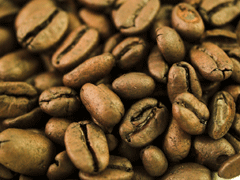
Genetically modifying coffee beans could eliminate the need to strip beans of caffeine. (Photo: Brian Lary)
STILES: We take the gene, and sort of turn it around backwards, and make it work in reverse.
GRANT: Normally, that caffeine-making gene sends out what's called messenger RNA, which goes from the nucleus into the body of the cell. There it's translated into the key enzyme that starts the caffeine making process. Flipping the gene around stops the process.
STILES: And so the enzyme doesn't get made. No enzyme, it can't do that first step, so no caffeine can be made.
GRANT: Stiles hopes to plant his decaf coffee trees in the field next year, and that's the next step in getting them approved for market. I'm Julie Grant.
GELLERMAN: Our story about decaf coffee beans is served up courtesy of SoundVision Productions in Berkeley, CA.
A Recyclable Olympic Stadium

A computer-generated image of the 2012 Olympic stadium. (Courtesy of the EPA)
You’ve heard about Beijing traffic, China’s smog, and toxic algae blooms – now let the Games begin!
[MUSIC: OLYMPIC THEME SONG]
GELLERMAN: But first this cool fix for a hot planet from Kim Gittleson.
GITTLESON: The Beijing Olympics are not yet underway but planning for the 2012 London Olympics has already begun.
In keeping with London’s pledge to be the first “sustainable” games, the design for the Olympic Arena proposes another first: a recyclable stadium.
[MUSIC: COOL FIX THEME]
The London Games organizers are trying to avoid the mistakes of Olympics past - especially those empty, unused stadiums on the outskirts of cities like Rome and Montreal.

An computer-generated image of the London 2012 Olympic stadium. (Photo: PR)
Where it gets interesting is at the top of the stadium. This level will have 55,000 “transportable seats” that will be bolted, rather than welded together. That way, the seats can be removed and transported to the next Olympic venue. This top tier will be built out of low-impact materials, including a recyclable fabric façade made out of hemp. The architects hope by minimizing materials they will reduce the expense and environmental impact of transporting the stadium to different locations.

(Courtesy of the EPA)
Now that’s worth a gold medal.
That’s this week’s Cool Fix for a Hot Planet. I’m Kim Gittleson.
GELLERMAN: And if you have a Cool Fix for a Hot Planet, we’d like to know it. If we use your idea on the air, we'll send you a very cool electric blue Living on Earth tire gauge. Keep your tires properly inflated and you could save over $500 a year in fuel. That according to a study done at Carnegie Mellon University. Call our listener line at 800-218-9988, that's 800-218-99-88. Or email coolfix—that's one word—at loe.org. That's coolfix at l-o-e dot org.
[MUSIC: The Bad Plus “We Are The Champions” from ‘Blunt Object’ (Sony Music)]
GELLERMAN: On the next Living on Earth: Geologists say it’s the end of the world as we know it - thanks to humanity.
SOUND: 15 million years in the future the changes that are happening right now will look almost akin to the meteorite strike, which it is thought killed off the dinosaurs.
GELLERMAN: It’s the dawning of the age of the anthroposcene, next time on Living on Earth.
GELLERMAN: We leave you this week in the midst of Brazilian rain forest
[Earth Ear: Eloisa Matheu “Mata Atlantica” from ‘Brazilian Soundscapes’ (Sittelle Records—1993)]
GELLERMAN: With the night-time chorus of chirruping insects in the Mata Atlantica forest that runs along Brazil’s Atlantic coast. Listen carefully and you’ll hear frogs and toads ribbetting away the hours of darkness. Eloisa Mattheu recorded these insects and amphibians for the CD Brazilian Soundscapes.
GELLERMAN: Living on Earth is produced by the World Media Foundation. Our crew includes Ashley Ahearn, Bobby Bascomb, Eileen Bolinsky, Ingrid Lobet, Helen Palmer, Mitra Taj and Jeff Young, with help from Sarah Calkins and Marilyn Govoni.
Our interns are Luke Borders, Kim Gittleson and Jessica Ilyse Smith. Jeff Turton is our technical director. Alison Lirish Dean composed our themes. You can find us at L-O-E dot org. Steve Curwood is our executive producer. I’m Bruce Gellerman. Thanks for listening.
ANNOUNCER: Funding for Living on Earth comes from the National Science Foundation, supporting coverage of emerging science, and Stonyfield Farm: organic yogurt and smoothies. Stonyfield pays its farmers not to use artificial growth hormones on their cows. Details at stonyfield.com. Support also comes from you our listeners, the Ford Foundation, the Town Creek Foundation, and the Oak Foundation supporting coverage of climate change and marine issues, the Rockefeller Foundation and its campaign for American workers, more at rockfound dot org. And Pax World Mutual Funds: socially and environmentally sustainable investing. Pax World: for tomorrow. On the web at paxworld.com.
ANNOUNCER 2: PRI: Public Radio International.
Living on Earth wants to hear from you!
Living on Earth
62 Calef Highway, Suite 212
Lee, NH 03861
Telephone: 617-287-4121
E-mail: comments@loe.org
Newsletter [Click here]
Donate to Living on Earth!
Living on Earth is an independent media program and relies entirely on contributions from listeners and institutions supporting public service. Please donate now to preserve an independent environmental voice.
NewsletterLiving on Earth offers a weekly delivery of the show's rundown to your mailbox. Sign up for our newsletter today!
 Sailors For The Sea: Be the change you want to sea.
Sailors For The Sea: Be the change you want to sea.
 The Grantham Foundation for the Protection of the Environment: Committed to protecting and improving the health of the global environment.
The Grantham Foundation for the Protection of the Environment: Committed to protecting and improving the health of the global environment.
 Contribute to Living on Earth and receive, as our gift to you, an archival print of one of Mark Seth Lender's extraordinary wildlife photographs. Follow the link to see Mark's current collection of photographs.
Contribute to Living on Earth and receive, as our gift to you, an archival print of one of Mark Seth Lender's extraordinary wildlife photographs. Follow the link to see Mark's current collection of photographs.
 Buy a signed copy of Mark Seth Lender's book Smeagull the Seagull & support Living on Earth
Buy a signed copy of Mark Seth Lender's book Smeagull the Seagull & support Living on Earth

